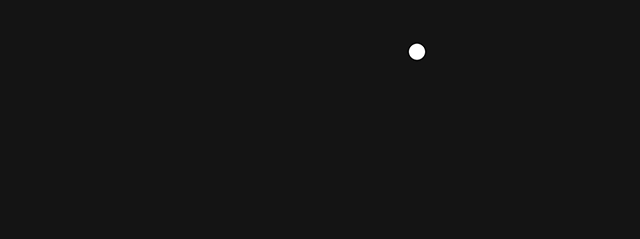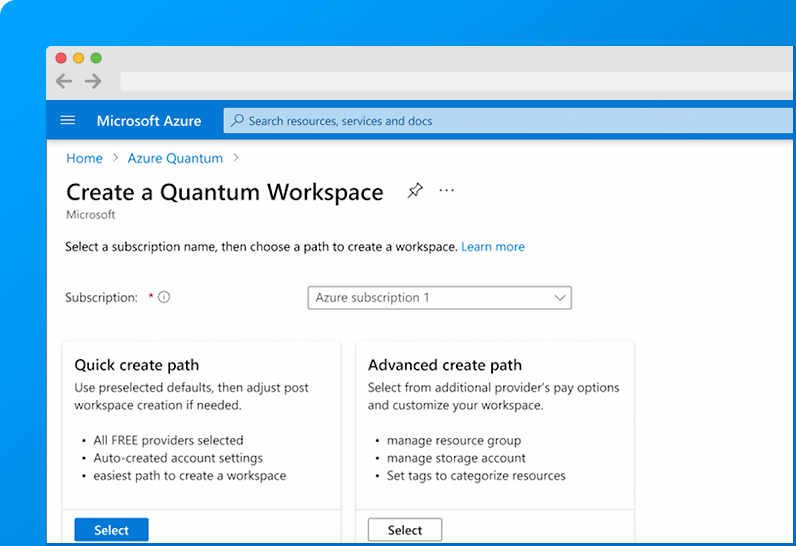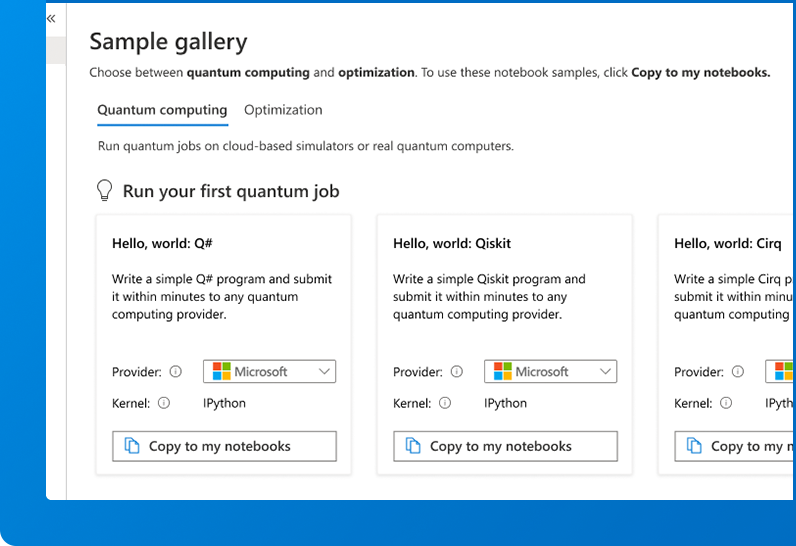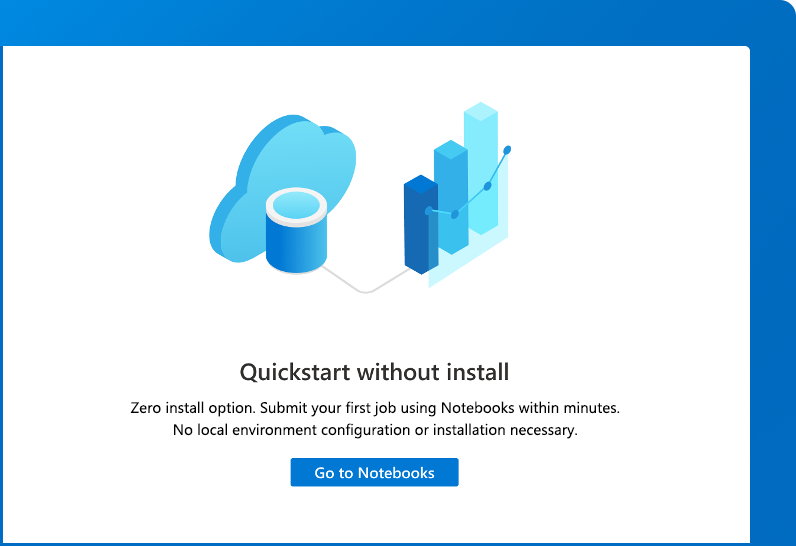Microsoft - Azure Quantum
Took onboarding workflows from frustration to flow, elevating success rates from 14.9% to over 70% through user-centered design
I established a UX research and design program for Azure Quantum, partnering with leadership to formalize design collaboration that elevated product quality and delivered a user-centered design culture.
The team was focused on increasing user engagement and adoption and had telemetry that indicated a 14.9% onboarding success rate, with over 85% abandonment of these first-run workflows. I joined the team to conduct user research and provide details to better understand the root causes of the attrition.
Timeframe: Apr ’21 – Sept ‘22
Team: Senior UX Designer (Me), 2x TPMs, 5x Quantum Software Engineers
My work: Research, Enterprise UX Design, Design system, Illustration, Branding, Marketing
Onboarding workflows initially only included Workspace creation and Overview page “Quickstart” exercises to submit a first quantum job. The Sample Gallery, Credits and Quota experiences, and the Credits program evolved from my user research and design direction, as well as cross-functional collaboration.
Baseline Research included:
Onboarding workflow telemetry - 14.9% of new users successfully completed the onboarding workflows, while more than 85% abandoned the process. Telemetry couldn’t explain why users were dropping at key points, and research was needed to uncover the details.
An initial PM user study - Nine participants, ranging from quantum developers to researchers and decision-makers, were all unable to complete onboarding first-run workflows within an hour. Outside of the study, some participants ended up taking 48 hours, with others taking more than a week.
Additional User sentiment study - Users felt the Azure Quantum onboarding experience should be more self-explanatory, claiming the experience was fragmented, lacked pricing details, and required frequent back-and-forth with documentation that created confidence barriers to making decisions.
I partnered with Product Management to cross-functionally socialize these insights and drive the definition of the high-level UX Outcome and break onboarding workflows into separate projects.
High-level UX Outcome:
”Users can easily create an Azure Quantum workspace, submit a first quantum job, learn how to submit subsequent jobs, and clearly understand usage and pricing without contacting support.”
UX initiatives I drove across all work streams:
-
Create and build a pool of users for user research studies
Create and conduct thoughtful activities that built engagement and foster user research relationships
User surveys
User research
UX Office hours
Participate in PM office hours
Increase user trust, through creating meaningful, helpful user relationships
-
Built and increased product team cross-functional awareness and understanding of user needs, expectations, goals, and pain points.
Championed and fostered product team cross-functional participation in user research
Defined initiatives to provide cross-functional visibility, participation, and ownership of user-centered design decisions
-
Improve my personal Azure framework pattern visibility and knowledge.
Create and drive presentations for design reviews of proposed solutions with the framework team.
Enable Azure Quantum engineering visibility of new and evolving framework implementation details.
-
Improve content organization, visibility, clarity, actionability across documentation.
Validate documentation clarity with user testing and internal product team review cycles.
Reduce inconsistencies between documentation and inline product learning materials.
* This case study is focused on using Azure Quantum portal onboarding workflows to submit quantum jobs, and does not cover CLI, Quantum Developer Kit (QDK) / VS Code, or Azure Quantum Python SDK options for submitting quantum jobs.
Azure Quantum - Workspace creation
SITUATION:
There are four main pages to Azure Quantum Workspace Creation:
Basics / Providers / Tags / Review + Create
Each page had several incremental steps with telemetry insights indicating attrition throughout the workflow, but no indication to explain what was causing it.





Additional workflow analysis research with quantum thought leaders, researchers, developers, enthusiasts, and practitioners highlighted specific points of friction that contributed to the confusion and high abandonment rates.
Confusing page messaging
Lack of calls-to-action
Lack of familiar Azure pattern alignment and frustration with a disjointed workflow
Frustration and confusion on basic information inputs
Costly and under-informed provider decisions
Frustration with Terms of Service (ToC) agreement positioning - ToC details were displayed with each provider during provider selection, but the ToC acceptance was positioned at the end of the workflow on the Create and Review page.
Frustration with overwhelming documentation
“Is it meant to look complicated? Because it does.”
- Research participant
PROCESS:
Synthesized research insights and journey-mapped the user’s experience to provide visibility and a common understanding of the user’s current experience.
Users were not having a pleasant journey.😖
Conducted a workshop focused on simplifying workspace creation, to socialize the design discussion, and gain team input and alignment on onboarding strategies
This cross-collaborative approach provided a deep understanding of the user’s experience across the team, enabling co-discovery and co-definition of the desired UX Outcome, success, and progress metrics.
UX Outcome:
“First-time users can easily identify a clear path to create an Azure Quantum workspace and build a higher degree of trust and user confidence through initial success in the onboarding process.”
Success metrics and progress metrics:
-
Increase clarity and trust in the call-to-action through effective messaging
Decrease the time users spend completing each task
Reduce attrition due to the storage account creation requirement
-
Increased user comprehension by clarifying the primary call-to-action
Increase the click-through rate of the primary call-to-action
Increase user comprehension of provider offerings
Reduce decision friction
Reduce Terms and Conditions confusion
Reduce the time needed to select a provider, and improve decision confidence
Improve user trust through pricing clarity
-
Reduce confusion about the requirements of defining tags
-
Reduce confusion about primary call-to-action
Reduce confusion about Terms of Service requirements
Possibly create a bulk acceptance
Possibly create an acceptance coupled / inline with provider selection step
Reduce user uncertainty around selected provider details, associated plans and pricing
Key initiatives -
Optimized workflows — Collaborated with engineering to identify opportunities to provide hint text and prefill values with known user data.
Simplified onboarding flow — Reduced decision points, pricing friction, and cognitive load, enabling faster first-job submission and higher completion rates.
Strengthened framework alignment and advanced Fluent components — Partnered with Azure Fluent PM and Design leadership to ensure consistency across components and patterns, and contributed to component variation design, documentation, and cross-team socialization.
Streamlined compliance — Worked with Microsoft Legal to simplify provider Terms & Conditions acceptance, removing a key blocker in workflow setup.
Enabled data-driven iteration and alignment — Created fully functional prototypes to facilitate design discussions, user research, and stakeholder feedback and alignment.
Validated through testing — User sentiment favored fewer, simpler choices and a “quick-start” low-code path before exploring advanced configurations.
Aligned documentation — Partnered with content teams to update and unify documentation with the revised user flow and design vision.
RESULTS:
Quick Create path
-
Increased immediate user success/reduced the immediate user failure and abandonment within the onboarding experience.
Increase user trust in Azure Quantum.
-
Basic page - Reduced need for user decisions - Only requiring Workspace name and Region selection
Basic page - Reduced time to set up a new storage account - Included a default storage account, with default settings that could be managed post workspace creation.
Provider selection - Reduced time needed for users to review Provider details and pricing within their organization - All FREE providers added by default.
Review and Create - Removed pricing ambiguity - highlighted all Provider Pricing, as FREE for Quick Create
Review and Create - Removed the need to accept Terms and Conditions for all FREE providers added by default.
Advanced create path
-
Adding informative titles
Adding helpful taglines
Standardizing on a framework pattern of using “Learn more” link to documentation
-
Clarified that users would be able to edit all provider details post workspace creation
Provided useful hint text in form inputs
Prefilled known user data
For subscription
For region
For storage account
Added a default option for a storage account with default settings
-
Added all FREE providers to workspaces being created by default
Provided better differentiation between Quantum Computing providers vs Quantum Optimization providers
-
Colocated provider T&Cs acceptance with the Provider “Add” function, enabling intentional association of the agreement with each provider selection.
Additional text was colocated with the “Create” button on the last step of the workflow to confirm acceptance of all selected provider Terms and Conditions. This read “By clicking create, you accept each included provider’s Terms & Conditions and Privacy Policy”
-
Included default settings
Mitigated the need for advanced customization
All storage account details could be customized post workspace creation
-
Provided additional pricing details within the review details
Included and highlighted all FREE provider plan details inline
-
Reduced user direction inconsistencies and solidified uniform workflow messaging
Reduced user uncertainty around selected provider details, associated plans and pricing by aligning Learning Materials with online documentation
Utilizing account details, we determined if the user had a current subscription and preselected the Quick create path, a two-step workflow that enables near-instant workspace creation. If no subscription was detected, users were led down the Advanced create path.
Quick-Create path - complete workflow




Advanced Create path - complete workflow
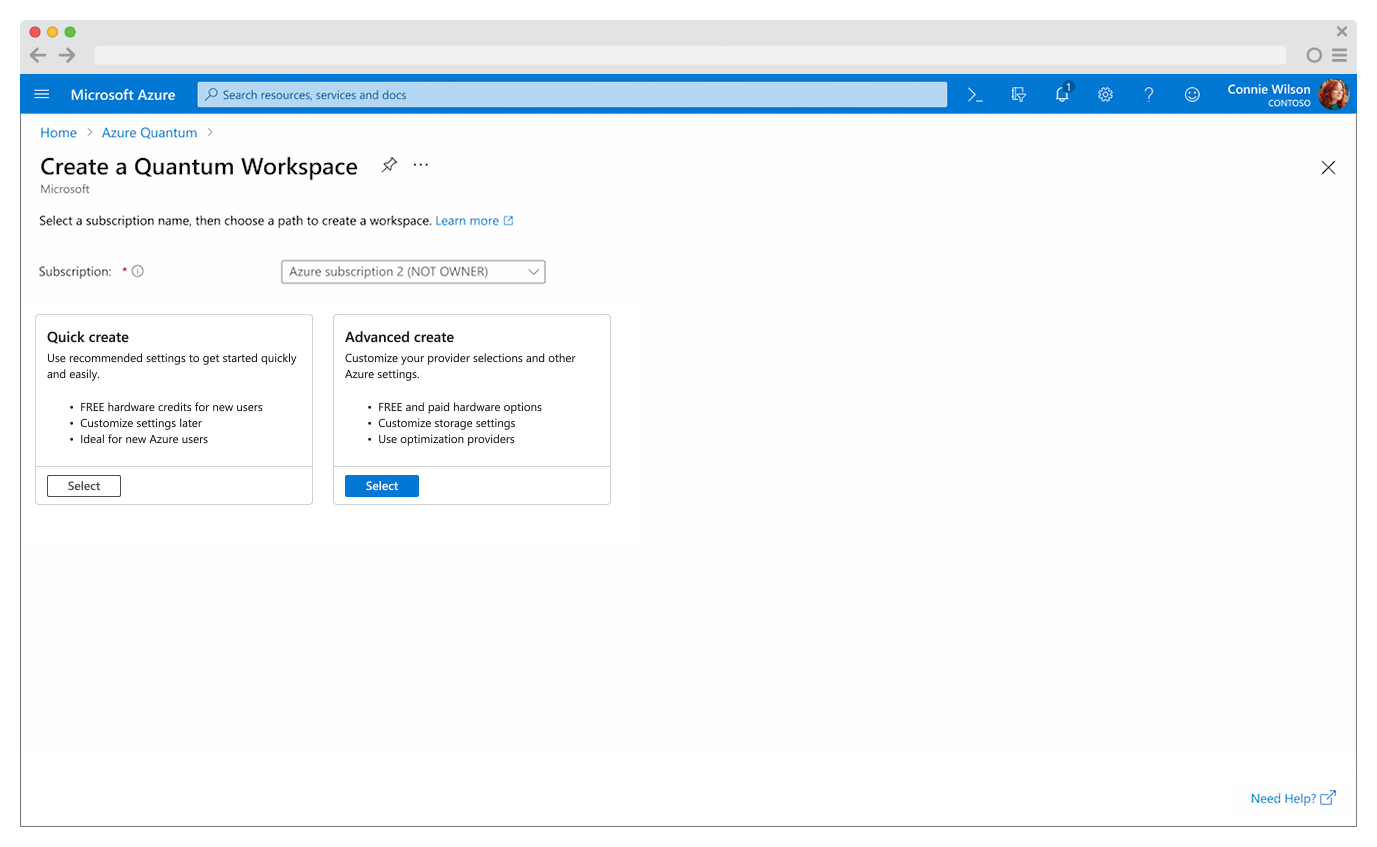
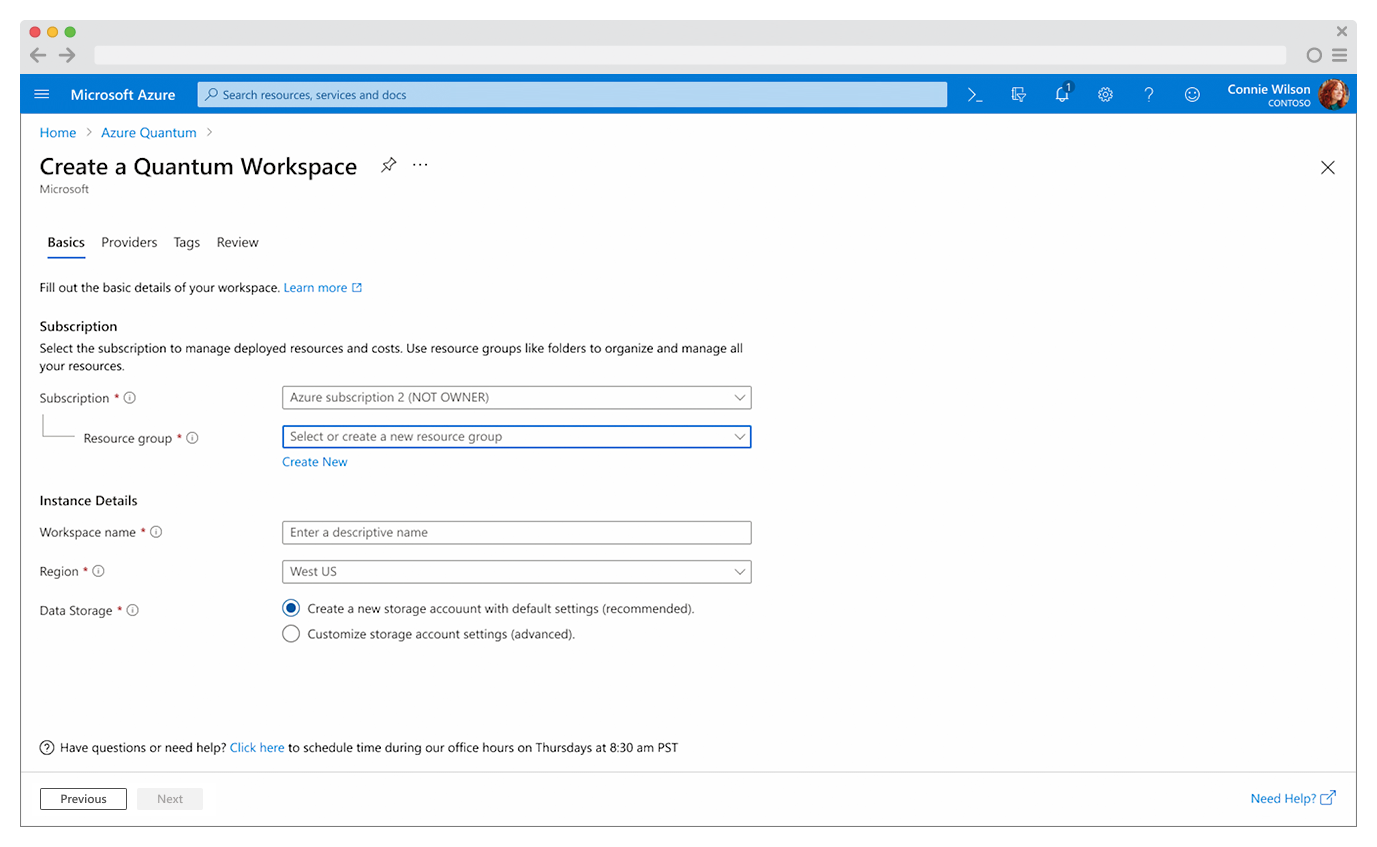

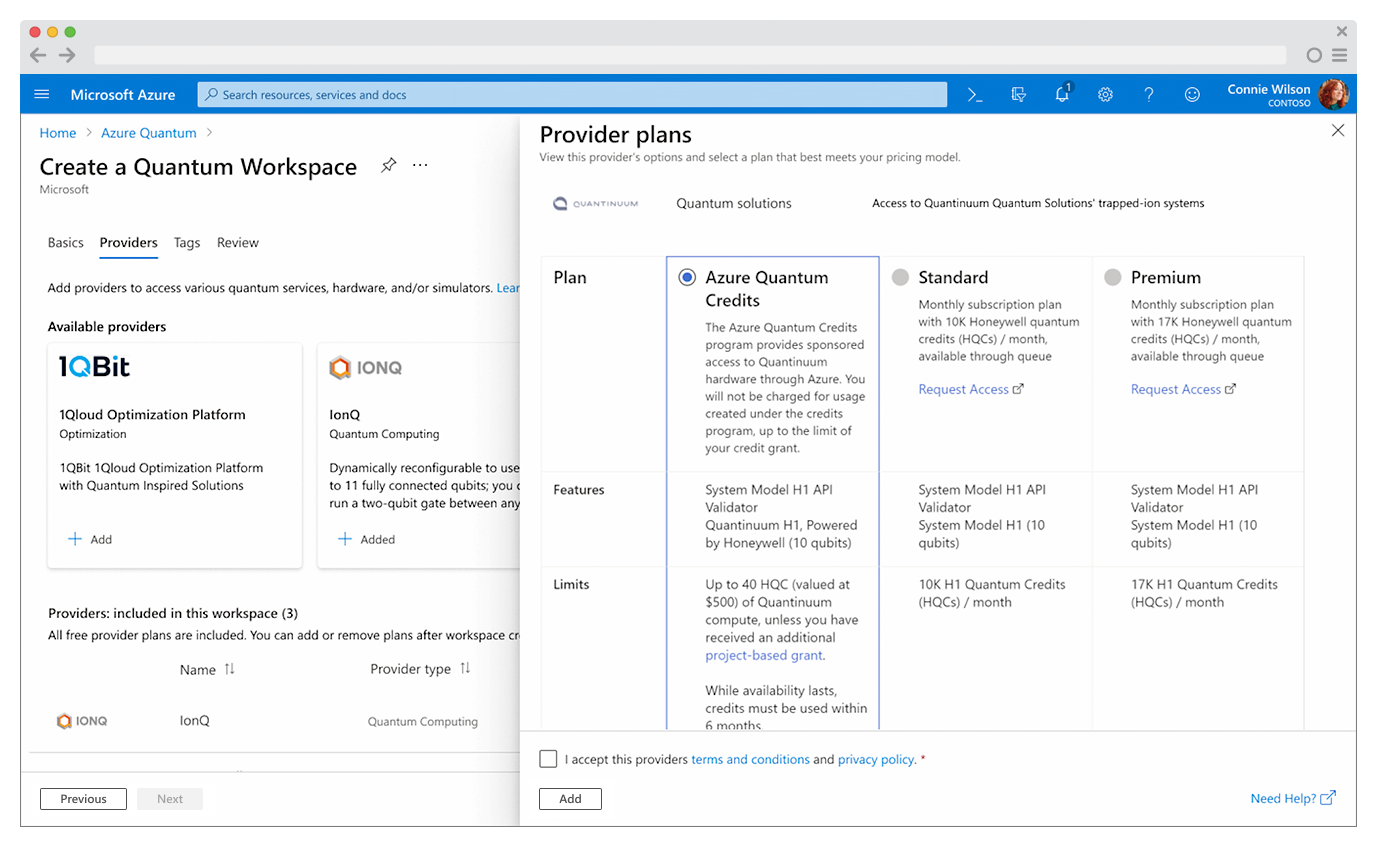


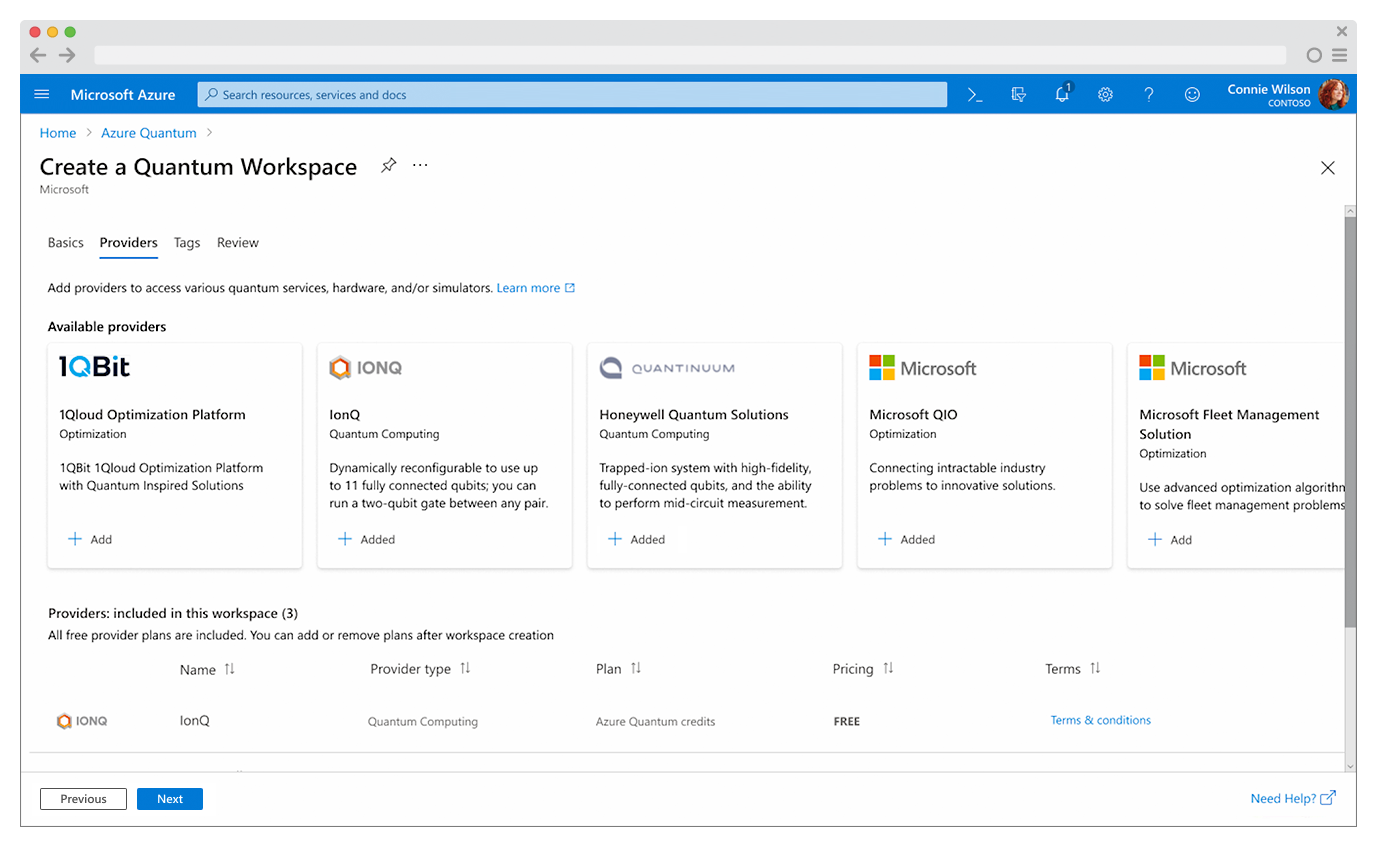



This work significantly improved onboarding success, enabling first-time users to create an Azure Quantum workspace in minutes and build a higher degree of trust and user confidence through initial success.
Workflow optimizations and the addition of the Quick Create path increased workspace creation success rates from 14.9% to 42%.
Azure Quantum - Overview page / Getting started
* This workstream ran in parallel to the following micro-case study for Sample Gallery. The outcome of the Overview page / Getting started workflows funneled new users into the Sample Gallery.
SITUATION:
User research revealed that the Overview page and its Quantum Computing Quickstart and Optimization Quickstart options were overwhelming for first-time users, and gated initial success. This process involved setting up your local environment in VS Code, adding the Azure Quantum Developer Kit (QDK) extension, installing any Python updates, and connecting Jupyter notebooks through an Azure Quantum workspace to submit programs to a remote quantum service. If the user wanted to do both quantum computing and quantum optimization, then they had to go through both of these setup configurations. Users were looking for an easy win to take back to their organizations, and these experiences left them feeling frustrated and overwhelmed.
PROCESS:
I conducted initial research with Quantum thought leaders, researchers, developers, enthusiasts, and practitioners to understand users’ perspectives and guide redesign discussions. By enabling cross-functional participation, I facilitated the co-discovery and co-definition of a UX Outcome (ideal user experience), success metrics (goals), and progress metrics (indicators) that we aimed to achieve for the Overview page experience.
UX Outcome:
“Provide a launching point that focuses new users on the easiest pathway to submit a first job, while supporting returning users and enabling sustained user education for all users.”
Success metrics and progress metrics:
-
Increase user trust
Increase common usability optimizations
Increase Azure Fluent framework pattern alignment
Reduce user friction and frustration
-
Decrease the % of users who abandon the page without taking action
Increase the % of users who can identify the quickest way to submit a first quantum job
Reduce distractions from the primary call-to-action
Increase understanding and success for all users
Increase the % of returning users who proceeded to Learning Materials
-
Reduce complexity
ncrease the success rate and job submission by following Quickstart path
Research highlighted two clear themes that users required to adopt Azure Quantum:
Users needed first-run success, subsequent-run success, and accessible support and documentation, to demonstrate capabilities to their organization.
Users wanted easier Quickstart exercises. One participant suggested integrating Jupyter notebooks (details) into Getting Started exercises, providing pre-made interactive environments as starting points for learning and exploration.
Focusing on Jupyter notebook integration and technical feasibility, I conducted Figjam workshops, design lunch-and-learns, and UX office hours, enabling visibility, participation, and a cross-functional understanding of user intentions, expectations, and goals.
These exercises aligned engineering and product management with a user-centered perspective for the Overview page redesign and the repositioning of “Quickstart” exercises.
Engineering leadership was initially hesitant to prioritize the Jupyter notebook option over local environment setup, so I couldn’t reprioritize the Jupyter notebook option as the “Quickstart” option. Aside from this Quickstart renaming idea, I developed a design proposal to meet the needs of both new and returning users, and enable additional learning opportunities for all users, then conducted usability tests to gather user insights on this idea and present them back to the team.
The design featured a three-panel layout that catered to new and returning users.
Start with Azure Quantum Notebooks – a guided, interactive starting point for beginners.
Access Quickstart Exercises – the local configuration option, and more advanced setup for more experienced users (still labelled Quickstart 😖).
Start with Learning Materials – links to documentation for discovery and deeper user exploration.
I felt this 3-part design direction provided comprehensive coverage for all users’ needs, and it resonated well with the team.
However, in research, users again voiced concern with the local configuration positioned as the “Quickstart Exercises”, they felt these initial exercises were too complex for new users. 4/5 quantum researcher study participants selected the more advanced method over a much simpler option of using templated/premade Jupyter notebooks samples, then ended up confused over the complexity.
When asked why participants chose this option, they said…
“because it’s labeled quickstart”.
This research data was still unable to convince engineering stakeholders that the Jupyter notebooks should be positioned as the Quickstart exercises over local configuration.
From listening to the users directly, I was fairly certain we needed to reposition these two options, so I created two additional variations that prioritized Jupyter notebooks as the Quickstart option:
Variation one - featured a three-panel layout, but labeled Jupyter Notebooks as the “Quickstart” option.
Variation two - completely removed all other calls-to-action, and highlighted the Jupyter Notebook option as “Quickstart without install”.
I conducted one final A,B,C,D usability test with six participants and included all options we had created for the Overview page. These last two variations, which repositioned Jupyter Notebooks as the “Quickstart” option, resonated best with users, with 6/6 users preferring variation two, which presented Getting Started as “Quickstart without install” and repositioned the Local configuration option in the navigation alongside Learning Materials. This option mitigated decision fatigue and decreased the likelihood of early abandonment by deprioritizing the more challenging path.
RESULTS:
The redesigned Overview page focused the navigation on initial success through “Getting started” experiences and Sample Gallery, while providing “Local configuration” options for more advanced users and empowering engagement for all users through additional “Learning materials”.
Additional benefits of this option included moving Quota usage to the Operations left-side menu, and co-locating it with Credit Usage and Job Usage, creating a more intuitive entry point and a holistic view of usage while removing clutter from the Getting Started workflows.
-
Increased trust and user confidence through more effective terminology and helpful explanations.
The introduction of Sample Gallery provided onboarding/first-run experiences for new users and engagement for all users. Sample Gallery offered premade Jupyter notebook “Hello world” introductory workflows, enabling first quantum submission, while introducing a direct avenue to higher engagement for returning and advanced users.
Enabled a more effective user flow by removing obstacles (Quota Utilization and Job Activity), and focused users on the primary action of first job submission success.
Aligned UI patterns with the Azure Fluent framework for greater familiarity and usability consistency
Empowered users educational engagement through concise, contextual inline “Learning materials”.
-
Decreased new user abandonment by providing a clear primary call-to-action to an easier path to submit a first quantum job.
Reduced distractions from the primary call-to-action of submitting a first quantum job by removing Quota Utilizations and Job Activity. Both of these options were only useful after jobs were being submitted.
Reduced the need for user support by increasing the availability of helpful information for submitting quantum jobs through the addition of “Learning materials”.
-
Decreased user confusion and frustration by reframing the “Quickstart” option as an introduction to Sample Gallery. This offered first-run users “Hello world” exercises to submit first quantum jobs and additional opportunities for returning user engagement.
Removed the barrier to entry presented by local configuration and learning and coding with Azure Quantum’s Q# for first-run activities.
Reduced the complexity of onboarding exercises and increased the avenue to initial user success, by introducing familiarity and ease-of-task-completion and with pre-made Jupyter notebooks.
-
Documentation content alignment between online documentation and inline product documentation.
Provided consistent tone and information architecture from one authoritative source of truth. All inline documentation provided links to identical online documentation.
Established a unified information architecture and consistent voice by centralizing documentation in a single source of truth, ensuring all inline references linked to identical online content education.
* This work and included research, sparked the creation of the Notebook Gallery (explained in the next micro case-study below👇🏼), enabling user discovery, exploration and learning through templated Jupyter Notebooks to submit Azure Quantum Jobs.
Azure Quantum - Notebook gallery Sample gallery
* This initiative ran in parallel to the Overview / Getting Started workflow, which funneled new users into the Sample gallery.
SITUATION:
Drawing from user research insights, workshops and UX office hours, I partnered with engineering to define the Notebook Gallery and its intent, to teach foundational taxonomy, structure, process, and lower barriers to first success in quantum computing, while fostering long-term engagement through sample-driven task completion using a curated collection of pre-built Jupyter Notebooks. I had created some initial comps for discussions, but due to my focus on competing parallel initiatives, this initial UI was created by engineering and moved to production before a full UX refinement cycle could be completed.
* Jupyter notebooks are interactive environments (details) that provide interactive computing, data analysis, and visualizations in one place, combining the functionality of a document within a code editor.
PROCESS:
Notebook Gallery work began by setting up telemetry and gathering usage data over a 20-day observation period that provided the following insights:
30% of users who visited Notebook Gallery didn’t take any further action, leaving the page.
58% of users who accessed the Notebook Gallery cloned a notebook to use.
50% of these users actually utilized the notebook and ran at least one cell (so 29% of users who initially took action to clone a notebook actually tried to execute a single task).
Only 17% of users who landed on Notebooks Gallery, cloned a notebook, then completed the notebook sample workflow, and actually submitted a quantum job.
In two scenarios where users were trying to submit a quantum computing job using two separate providers, there was a 75% failure and a 100% failure, respectively, due to not provisioning the correct provider during workspace creation.
Additional user research, coupled with this telemetry, was incorporated into workshops and UX office hours discussions, helping to define the UX Outcome we intended to provide users and the success metrics we aimed to improve.
UX Outcome:
“Both new and returning users can easily explore, learn, and build through hands-on, partner-driven examples and submit quantum computing and quantum optimization jobs through Jupyter Notebooks.”
Success metrics and progress metrics:
-
Improve user understanding of what a (Jupyter) “Notebook” is and how to use it to submit a Quantum job.
Increase page call-to-action and improve overall usability
Reduce content overload
Increase the % of success for users that clone a specific quantum computing (QC) or quantum optimization (QO) sample and are not able to successfully run it due to not having provisioned one or the other QC or QO providers respectfully. - Users are landing on the Sample Gallery without a provider provisioned that can run selected samples.
-
Revise/remove unnecessary clutter, enabling user focus on primary call-to-action.
Provide more informative titles and helpful, taglines and sample descriptions.
Provide opportunities for sample gallery page engagement.
Provide opportunities for individual samples’ engagement
-
Partner and align with Azure Jupyter notebook teams.
Enable better visibility and understanding around engagement best practices.
Enabled better Azure Jupyter notebook pattern alignment.
-
Review and revise messaging within notebooks.
Partner with engineering to streamline notebook samples.
-
-
I invited the cross-functional team to participate in usability research, revealing to them firsthand significant usability and communication gaps that led to user confusion, frustration, reduced engagement, and hindered quantum job submissions.
Provided a valuable perspective that enabled a more constructive cross-functional user-centered mindset in workshops and UX office hour discussions
Fostered shared understanding and accountability, aligning teams around UX Outcomes and measurable success metrics.
Key Research insights - leading to low engagement, abandonment, and fewer job submissions:
3 of 6 participants were unfamiliar with Jupyter Notebooks or their intended use.
4 of 6 participants were unable to complete the task of copying and submitting a notebook within one hour.
2 of 6 participants expressed a need for a clearer “Hello World” style introduction to orient new users to the gallery.
Advanced samples were difficult to find; gallery navigation lacked clarity.
Inconsistent notebook explanations and missing contextual guidance.
Unclear messaging, poor labeling, and weak calls-to-action.
Search bar placement and results were ineffective.
Workflow confusion around submitting jobs and provider selection.
Provisioning blockers prevented new users from submitting samples.
UI issues such as unused icons and irrelevant tags cluttered the interface.
No introductory content to support first-time users or guide initial success.
“The page appears visually monotonous and is not optimized for specific use cases.”
- Quantum Educator
Guided by telemetry data and direct user feedback, I focused design efforts on delivering our UX Outcome through a more intuitive, engaging, and user-centered experience. I created all design media, facilitated cross-functional discussions, and led iterative research cycles that rapidly informed and refined the vision.
Key initiatives -
Clarified content hierarchy through more informative category titles, call-to-action taglines, and page messaging.
Renamed “Notebook Gallery” to “Sample Gallery” to better communicate purpose and context.
Refined card components—standardizing titles, explanations, and calls-to-action to emphasize Azure Quantum’s provider-agnostic and code-agnostic capabilities.
Collaborated with Quantum engineers to design more engaging and educational sample experiences.
Aligned with Azure Fluent design system PMs and designers to ensure consistency with Fluent interaction patterns and visual standards.
RESULTS:
Specific telemetry metrics:
Within 2 months after implementation, close to 50% of all users who landed on the Sample Gallery cloned a notebook, completed the notebook sample workflow, and submitted a quantum job.
Drastically reduced the 75-100% failure rate of Quantum Computing (QC) gallery samples’ run-ability to a 0% failure rate, through provisioning all FREE QC and QO providers by default during Workspace Creation, enabling users to clone and submit both QC and QO samples upon Sample Gallery entry.
Specific user research metrics:
-
Renamed “Notebook Gallery” to “Sample Gallery” to better communicate purpose and context.
Included welcoming call-to-action “Hello World” samples for both Quantum computing and Quantum Optimization options
Provided a familiar introductory experience to unfamiliar technologies
Enabled visibility into the easiest path for quantum job submissions
Improved user understanding of Jupyter Notebooks and how to utilize them to submit quantum jobs through the addition of inline links to documentation.
Increased page usability by providing more informative titles, helpful taglines, and sample descriptions.
Reduced content overload by providing helpful Quantum computing / Quantum Optimization categorization. Hello worlds helped with this too.
-
Removed unnecessary clutter - enabling users to focus on the Sample Gallery content and the primary call-to-action of submitting quantum jobs.
Removed the page’s search bar, that was not useful with the small amount of content currently included in the gallery.
Removed the useless (i) information icon
Removed the tags, that were also not useful with the small amount of content currently included in the gallery.
Provided opportunities for sample gallery page engagement, by focusing users through meaningful titles, helpful action-oriented taglines, and informative descriptions.
-
Partnered with Azure Jupyter notebook teams.
Enable better visibility and understanding around engagement best practices.
Enabled better Azure Jupyter notebook pattern alignment.
-
Reversed the 75%-100% failure rate to a 100% success rate by enabling at least one FREE QC and one FREE QO provider to be added during workspace creation.
-
Enabled QC and QO categorization.
Provided samples that aid in onboarding success through the included “Hello World” Samples
Provided samples that aided in continued learning and advanced user success, through working with quantum developers and Quantum researchers to create more engaging and interesting samples.
-
Enabled a provider selection component within each sample, highlighting the ability to switch between providers
Enabled a kernel selection component when possible, per sample, highlighting the ability to select a preferred language.
After 6 months, 88% of surveyed users agreed with the statement for the redesigned experience: “Sample Gallery is integral to learning, exploration, and understanding of Azure Quantum's offerings.
“They're super, super stripped down, like the simplest possible kind of thing, really just showing how it all just fits, which is perfect. Because it gets you started, so it does what it's intended to do, which is getting going and started, so it's really great!”
- Quantum explorer
The Sample Gallery redesign balanced the needs of first-time and advanced users, featuring “Hello World” options to guide new users through their first quantum job, while providing advanced samples and learning resources for returning users.
Azure Quantum - Credits and quotas
SITUATION:
User research on the Credits and Quotas experience revealed that many users faced difficult conversations communicating funding needs within their organizations. Users explained that the Credits and Quotas experience wasn’t helping these conversations, describing the existing dashboards and visualizations as confusing, ambiguous, and lacking actionable insights, making it difficult to interpret usage or justify ongoing investment in quantum research and using Azure Quantum.
PROCESS:
I conducted user research to gather insights, highlight opportunities for optimization, and frame the above challenge to the team, focusing our efforts on presenting a more intuitive way to display quota and credit details.
Key Research insights -
Across two separate studies (12 participants total), users consistently identified five key pain points that eroded comprehension, confidence, and overall trust within the Credits and Quotas experience.
Confusing, subjective data visualizations made it difficult to interpret usage or value.
Missing subscription quota and credit breakdowns limited transparency into available resources.
Insufficient pricing and usage data left users unable to make informed, high-cost decisions or facilitate meaningful budget discussions with their organizations.
Unclear credit program details and lack of self-service options for requesting credit increases or upgrades led to user frustration.
Dependence on Azure Quantum support for basic inquiries increased operational overhead for support and product management teams.
Cross-functional participation throughout this research enabled co-discovery, co-definition, and alignment on the UX Outcome and the success and progress metrics necessary to guide a more transparent, user-centered design direction.
UX Outcome:
“Users can clearly understand credit and quota usage to easily make determinations about their organizational usage needs, and take action to remove credit and quota limitations and alleviate pricing concerns.”
Success metrics and progress metrics:
Initially, there was nothing to measure with telemetry in the experience, as it lacked tasks, workflows, calls-to-action, or instrumentation to apply telemetry to. User research provided the following details.
-
Per subscription
Per workspace
-
Subjective data visualizations created uncertainty - there wasn’t a standardized, familiar visual presentation of usage.
For credit usage
For quota usage
Users didn’t know how to identify if credits were available per provider or validate the amount used from the UI.
No opportunity to increase quota
No opportunity to add/increase credits
-
No visibility into types of pricing plans was available through the Credits and Quota UI.
Users had to revise plan selection through provider details or contact Azure Quantum support to increase their provider quota amounts. This process could take up to 24-48 hours, and delayed users work.
Users had to rely on online documentation to understand that Azure Quantum credits were available through an application process. The application process took up to a week in some instances.
-
Users were only able to be awarded credits by reaching out to support and speaking directly to product management.
Aiming to achieve our UX Outcome and improve trust in the Credits and Quotas experience, I focused design efforts on clarity, transparency, and aligning on common usability patterns, validating these solutions through user research and socializing insights with the team.
Collaborated with the Azure Fluent framework team to explore data-presentation patterns, aligning on a table layout commonly used for displaying usage results.
Iterated on minor data visualizations within these table components, driving component evolution, documentation updates, and broader system adoption.
Developed functional prototypes to facilitate design discussions, gather feedback, and refine the vision through rapid iteration.
Iteratively A/B tested table-based proposals to evaluate how effectively they communicated credit and quota data in a familiar, easily interpretable format.
Socialized research findings and design proposals across Product Management and Engineering via cross-functional presentations and weekly UX office hours, ensuring alignment and shared ownership of outcomes.
RESULTS:
Created the Credits and Quotas central hub for users to view and manage their Azure Quantum provider resources effectively.
-
Standardizing on Azure framework table patterns enabled a more familiar and easy-to-read presentation of the data.
Users were able to easily describe their subscription and workspace quota available, and the current amount used.
The addition of a simple bar graph accompanied with the provider’s units of measurement enabled a easy to understand data visualization.
Each provider row within the table could be expanded in an accordion to display the types of plans available and one of three types of pricing plans being used.
Standard plan - measured by the selected provider quota agreement.
Pay-as-you-go plan - users could pay to add compute as needed.
Credits plan - measured by Azure Quantum allotment.
-
Users were able to increase quotas directly from the table and the Providers they had provisioned.
Users were able to link to a form to apply for credit or request an increase directly from the table and the Providers they had provisioned.
-
Users were able to apply for Azure Quantum credits on a per provider basis.
Credits were awarded to partnering quantum researchers who helped expand Sample Gallery content, fostering the Azure Quantum community.
Credits were awarded to universities, that enabled Azure Quantum exposure and use within their learning environments.
Credits were awarded to UX research participants.
Credits dashboard -
Quotas dashboard -
“ What really made the difference was these credits, this credit program that allowed us to experiment with what we were doing without using our own budget, which is very limited, so that was for us a game-changer. ”
- Quantum Innovator
The redesigned Credits and Quotas experience provided valuable user insight, inspired trust in Azure Quantum, and lowered the financial burden of learning quantum computing and quantum optimization. Users could manage quota availability and credit usage, request upgrades, apply for grants, and better plan for future projected costs and funding discussions within their organizations.
Overall impact
Final usability testing showed a 70% (7/10 participants) success rate for first-run workflows with quantum job submissions, marking a major leap in user trust and onboarding efficiency for the Azure Quantum program.
These UX design outcomes significantly improved user confidence, engagement, and productivity, enabling Azure Quantum users to achieve their short-term quantum goals, plan for funding conversations, and develop long-term quantum strategies within their organizations.
UX initiative results -
-
Increased the pool of users for user research studies through partnering with product management on support conversations and gaining user trust.
Increased visibility and the ability to manage UX research initiatives, by managing a spreadsheet, detailing users’ roles and responsibilities, needs and concerns, and willingness to participate in user research.
Increased user trust through engagement
Conducted quick surveys, providing updates on Azure Quantum initiatives and updates
Highlighted opportunities to gain Azure Quantum credits through user research participation
Weekly Azure Quantum PM office hours
Weekly Azure Quantum UX office hours
-
Increased product team user research participation
Increased participatory design activities
UX research and design socialization presentations
Conducted hands on workshops
Conducted weekly UX office hours
Increased user resaerch insights with online documentation team through bi-weekly discussions
Increased broad cross-functional alignment through visibility and engagement
-
Increased my Fluent knowledge and capabilities by reviewing system documentation.
Increased visibility of Azure Quantum UX work by partnering with Fluent system designers in bi-weekly design reviews and system discussions.
Increased Azure Quantum product team engineering alignment with new and evolving system details, initiatives, and requirements.
-
Within workflows
Within online documentation
